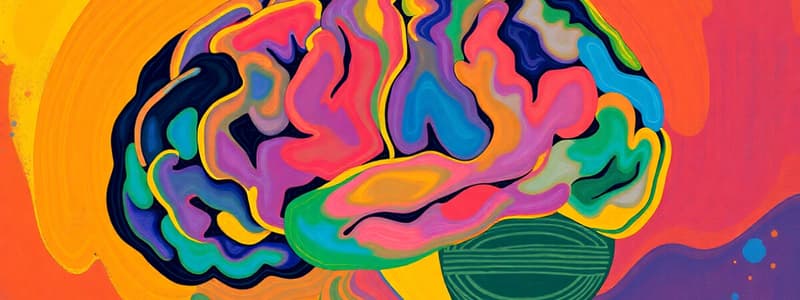Podcast
Questions and Answers
What is the primary function of the thalamus?
What is the primary function of the thalamus?
- To control feeding and drinking behaviors
- To regulate body temperature
- To store memories
- To receive most sensory input and send it to the cerebral cortex (correct)
What role does the hippocampus play in the brain?
What role does the hippocampus play in the brain?
- Facilitates sensory processing
- Responsible for motor control
- Important for the storage of memories (correct)
- Involved in the regulation of aggression
Which of the following structures is NOT a part of the basal ganglia?
Which of the following structures is NOT a part of the basal ganglia?
- Globus pallidus
- Putamen
- Amygdala (correct)
- Caudate nucleus
What is the function of cerebrospinal fluid (CSF)?
What is the function of cerebrospinal fluid (CSF)?
What condition results from the obstruction of cerebrospinal fluid flow?
What condition results from the obstruction of cerebrospinal fluid flow?
What part of the hindbrain is primarily responsible for controlling vital reflexes such as breathing and heart rate?
What part of the hindbrain is primarily responsible for controlling vital reflexes such as breathing and heart rate?
Which structure within the midbrain helps to process visual information?
Which structure within the midbrain helps to process visual information?
Which cranial nerve is responsible for tasting from the posterior one-third of the tongue?
Which cranial nerve is responsible for tasting from the posterior one-third of the tongue?
What is the primary function of the cerebellum?
What is the primary function of the cerebellum?
Which part of the hindbrain is specifically known as a 'bridge' connecting different structures of the brain?
Which part of the hindbrain is specifically known as a 'bridge' connecting different structures of the brain?
Flashcards are hidden until you start studying
Study Notes
Major Divisions of the Brain
The Hindbrain
- Known as the rhombencephalon, consisting of three main parts: medulla, pons, and cerebellum.
- The medulla controls vital reflexes including breathing, heart rate, vomiting, salivation, coughing, and sneezing via cranial nerves.
- Pons lies anterior and ventral to the medulla, acting as a "bridge" for axons that cross from one side of the brain to the other and contains nuclei for some cranial nerves.
- The cerebellum is responsible for motor coordination, balance, and processing visual and auditory stimuli.
The Cranial Nerves
- The brain has twelve pairs of cranial nerves, each responsible for different sensory and motor functions:
- I. Olfactory (smell)
- II. Optic (vision)
- III. Oculomotor (eye movements, pupil constriction)
- IV. Trochlear (eye movements)
- V. Trigeminal (skin sensations from the face)
- VI. Abducens (eye movements)
- VII. Facial (taste from front 2/3 of the tongue, facial expression, salivation)
- VIII. Statoacoustic/Vestibulocochlear (hearing, equilibrium)
- IX. Glossopharyngeal (taste from back 1/3 of the tongue, swallowing)
- X. Vagus (sensations from neck, control of throat, larynx, stomach/intestines)
- XI. Accessory (neck and shoulder movements)
- XII. Hypoglossal (controls tongue muscles)
The Midbrain (Mesencephalon)
- Positioned between the hindbrain and forebrain, largely smaller than the forebrain.
- The tectum serves as the roof of the midbrain, housing superior (vision) and inferior (hearing) colliculi.
- The tegmentum covers several midbrain structures and contains nuclei for cranial nerves III and IV, responsible for eye movement.
- Substantia nigra is crucial for dopamine production and movement readiness.
The Forebrain (Telencephalon)
- The outer portion is the cerebral cortex (cerebrum), encompassing essential structures like the diencephalon, including thalamus and hypothalamus.
- Thalamus acts as a relay station for most sensory input before it reaches the cerebral cortex.
- Hypothalamus regulates various functions including feeding, drinking, temperature control, and hormonal messaging to the pituitary gland.
The Forebrain: Basal Ganglia
- A group of subcortical structures located laterally to the thalamus, including caudate nucleus, putamen, and globus pallidus.
- Deterioration of these structures can lead to Parkinson's and Huntington's disease, affecting movement, mood, memory, and attention.
- Plays a role in enhancing selected actions and is involved in skill and habit learning.
The Forebrain: Limbic System
- A network of structures underneath the cerebral cortex, important for memory and emotion.
- Amygdala helps in differentiating objects necessary for survival, related to aggression and social behavior.
- Hippocampus is vital for the storage and retrieval of memories.
The Forebrain: Ventricles
- Central nervous system develops as a tube with a fluid canal, which becomes the central canal and ventricles filled with cerebrospinal fluid (CSF).
- Choroid plexus within ventricles produces CSF, which cushions the brain and provides buoyancy.
- Meningitis refers to inflammation of the protective membranes surrounding the brain and spinal cord, causing significant pain.
- Hydrocephalus results from obstructed CSF flow, leading to increased pressure in the brain and skull expansion.
The Forebrain (Prosencephalon/Telencephalon)
- The most anterior and prominent part of the brain consists of two cerebral hemispheres.
- Each hemisphere is organized to receive sensory information from the opposite (contralateral) side of the body.
Studying That Suits You
Use AI to generate personalized quizzes and flashcards to suit your learning preferences.




